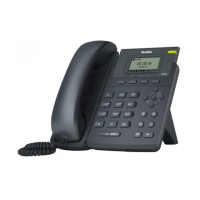Setting Up Your System
129
Users can also select to clear the user personalized configuration settings. Users can clear the
MAC-local CFG file using the following methods:
To clear the MAC-local CFG file, reset the IP phone to factory configuration settings by
selecting Reset local settings via phone user interface (navigate to Menu->Advanced
(default password: admin) ->Reset Config).
To clear the MAC-local CFG file, reset the IP phone to factory configuration settings by
navigating to the Upgrade menu via web user interface and clicking Reset local setting.
Configurations defined never be saved to the <MAC>-local.cfg file
Most configurations made by users via phone user interface and web user interface can be
saved to the <MAC>-local.cfg file, but some static settings will never be saved to the
<MAC>-local.cfg file. For more information, refer to Appendix F: Static Settings on page 969.
You need to reset the phone configurations not saved in the <MAC>-local.cfg file separately.
For more information, refer to Resetting Issues on page 930.
By default, the MAC-local.cfg file will be stored on the IP phone. The IP phone can be configured
to upload this file to the provisioning server each time the file updates. For more information,
refer to the parameter “static.auto_provision.custom.sync” described in the section
Configuration Parameters on page 148.
Custom CFG File
You can create some new CFG files (e.g., sip.cfg, account.cfg) containing any combination of
configuration parameters. This especially useful when you want to apply a set of features or
settings to a group of phones using the boot file.
For more information on how to create a new CFG file, refer to
Yealink_SIP-T2_Series_T19(P)
E2_T4_Series_T5_Series_W5_Series_IP_Phones_Auto_Provisioning_Guide_V81
.
Resource Files
When configuring some particular features, you may need to upload resource files to IP phones.
Resource files are optional, but if the particular feature is being employed, these files are
required.
If the resource file is to be used for all IP phones of the same model, the access URL of resource
file is best specified in the common CFG file. However, if you want to specify the desired phone
to use the resource file, the access URL of resource file should be specified in the MAC-Oriented
CFG file. During provisioning, the IP phones will request the resource files in addition to the
configuration files. For more information on the access URL of resource file, refer to the
corresponding section in this guide.
The followings show examples of resource files:
Language packs
Ring tones

